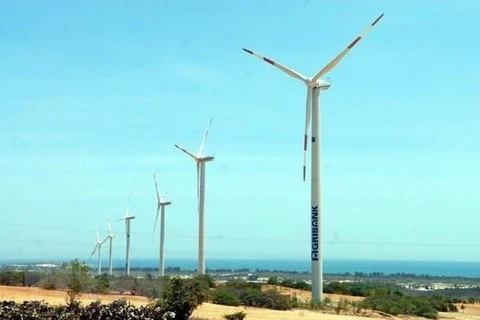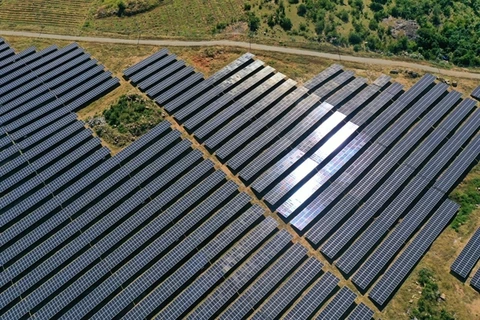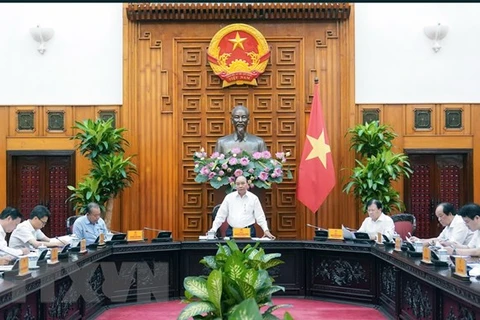Hanoi (VNS/VNA) - The Government should build a retail power price for industrial production firms equal to households and adjust the electricity tariff to suit people’s living standards, experts have said.
The Ministry of Industry and Trade (MoIT) is proposing reducing power price tiers from the current six to five levels.
Nguyen Anh Tuan, director of the ministry’s Electricity Regulatory Authority of Vietnam (ERAV), said the MoIT has provided four plans after collecting opinions from agencies, businesses and experts. Accordingly, the revision would keep the average retail power price unchanged and adjust the structure to suit actual electricity consumption.
Tuan said figures of power consumption among households in the US, the Republic of Korea, Thailand and Laos showed the retail price at the highest tier was 1.65 to 3 times higher than the lowest one. Therefore, the ministry proposed keeping an ascending mechanism. However, the current six tiers would be reduced to five as it ensures all households with power consumption of less than 700 kWh (98.2 percent of the total) would not be see increased power bills. In addition, the difference between the highest and lowest tiers would suit the world’s trend.
In recent days, many households were surprised with surging power bill sin May. Some had bills five times higher than the previous month, leading to calls for transparency in power prices to adjust electricity consumption effectively.
The ministry proposed increasing the power consumption gap between tiers to encourage electricity saving. At the same time, it is possible to limit the surge of power bills in peak seasons.
“With the principle of 'use more, pay more', with this plan, electricity costs for households having with consumption of more than 701 kWh (about 500,000 households, accounting for 1.7 percent of the total) would be increased by 29,000 VND (1.2 USD) per household per month,” he said.
Tran Viet Ngai, chairman of the Vietnam Energy Association (VEA), said the tiered pricing model is necessary to save energy. However, after years of application, it is time to have amendments to suit the current situation, especially with the number of households using less than 50 kWh per month lower.
Economist Ngo Tri Long said when consumers only use 100 kWh per month, the electricity price is very cheap. From tier 3 of more than 100 kWh, the prices are too high.
According to market principles, the more consumers buy, the cheaper the price is, but not in the electricity industry. When the tier pricing mechanism was introduced in 2014, many people found it unreasonable. But so far the price has not been revised, Long said.
Nguyen Tien Thoa, chairman of the Vietnam Valuation Association, said the current shortcoming of electricity price is that the Government allows cross-subsidisation to encourage production.
For electricity production, over the years, low-price electricity has been available at low hours to encourage production during off-peak hours and normal hours, restricting heavy electricity use during peak hours. This is still necessary, but power prices should not be sold less than production costs.
Tran Dinh Long, vice chairman of the Vietnam Electrical Engineering Association, said the tier pricing mechanism adjustment must take into account that households in urban areas with minimum common usage will receive reasonable electricity prices. High rates would be applied only for a sharp increase in usage.
The average electricity retail price is set for many groups of customers including production, business, administrative and non-business activities. Currently, households and business have to pay electricity prices higher than the average retail prices. Meanwhile, the retail power price for the industrial sector is lower, Long said.
According to figures in 2018, the industrial sector accounted for 54 percent of the country’s total power consumption while those of households and businesses were 35 percent and 9 percent respectively. This means users with less electricity had to pay a higher price to support those with higher consumption - including a large number of much power consumption sectors such as steel, cement and chemicals. Low electricity prices have not created pressure to force manufacturers to change outdated technologies.
Long added that people’s incomes and lives have been improved, making the minimum electric equipment in families also increase. Currently, households’ common power consumption is about 201-300 kWh per month. The price at these levels should not be too high compared to the current average retail tariff. Prices of above 400 kWh could be very high because the consumers at this level are well-off.
Statistics from the MoIT revealed that households with the power consumption of less than 100 kWh per month accounted for 35.8 percent of the total 25.8 million customers using electricity. Those with consumption of 101 to 300 kWh per month was 40 percent. Households with consumption of more than 300 and 400 kWh per month were 15 percent and 7 percent respectively./.
The Ministry of Industry and Trade (MoIT) is proposing reducing power price tiers from the current six to five levels.
Nguyen Anh Tuan, director of the ministry’s Electricity Regulatory Authority of Vietnam (ERAV), said the MoIT has provided four plans after collecting opinions from agencies, businesses and experts. Accordingly, the revision would keep the average retail power price unchanged and adjust the structure to suit actual electricity consumption.
Tuan said figures of power consumption among households in the US, the Republic of Korea, Thailand and Laos showed the retail price at the highest tier was 1.65 to 3 times higher than the lowest one. Therefore, the ministry proposed keeping an ascending mechanism. However, the current six tiers would be reduced to five as it ensures all households with power consumption of less than 700 kWh (98.2 percent of the total) would not be see increased power bills. In addition, the difference between the highest and lowest tiers would suit the world’s trend.
In recent days, many households were surprised with surging power bill sin May. Some had bills five times higher than the previous month, leading to calls for transparency in power prices to adjust electricity consumption effectively.
The ministry proposed increasing the power consumption gap between tiers to encourage electricity saving. At the same time, it is possible to limit the surge of power bills in peak seasons.
“With the principle of 'use more, pay more', with this plan, electricity costs for households having with consumption of more than 701 kWh (about 500,000 households, accounting for 1.7 percent of the total) would be increased by 29,000 VND (1.2 USD) per household per month,” he said.
Tran Viet Ngai, chairman of the Vietnam Energy Association (VEA), said the tiered pricing model is necessary to save energy. However, after years of application, it is time to have amendments to suit the current situation, especially with the number of households using less than 50 kWh per month lower.
Economist Ngo Tri Long said when consumers only use 100 kWh per month, the electricity price is very cheap. From tier 3 of more than 100 kWh, the prices are too high.
According to market principles, the more consumers buy, the cheaper the price is, but not in the electricity industry. When the tier pricing mechanism was introduced in 2014, many people found it unreasonable. But so far the price has not been revised, Long said.
Nguyen Tien Thoa, chairman of the Vietnam Valuation Association, said the current shortcoming of electricity price is that the Government allows cross-subsidisation to encourage production.
For electricity production, over the years, low-price electricity has been available at low hours to encourage production during off-peak hours and normal hours, restricting heavy electricity use during peak hours. This is still necessary, but power prices should not be sold less than production costs.
Tran Dinh Long, vice chairman of the Vietnam Electrical Engineering Association, said the tier pricing mechanism adjustment must take into account that households in urban areas with minimum common usage will receive reasonable electricity prices. High rates would be applied only for a sharp increase in usage.
The average electricity retail price is set for many groups of customers including production, business, administrative and non-business activities. Currently, households and business have to pay electricity prices higher than the average retail prices. Meanwhile, the retail power price for the industrial sector is lower, Long said.
According to figures in 2018, the industrial sector accounted for 54 percent of the country’s total power consumption while those of households and businesses were 35 percent and 9 percent respectively. This means users with less electricity had to pay a higher price to support those with higher consumption - including a large number of much power consumption sectors such as steel, cement and chemicals. Low electricity prices have not created pressure to force manufacturers to change outdated technologies.
Long added that people’s incomes and lives have been improved, making the minimum electric equipment in families also increase. Currently, households’ common power consumption is about 201-300 kWh per month. The price at these levels should not be too high compared to the current average retail tariff. Prices of above 400 kWh could be very high because the consumers at this level are well-off.
Statistics from the MoIT revealed that households with the power consumption of less than 100 kWh per month accounted for 35.8 percent of the total 25.8 million customers using electricity. Those with consumption of 101 to 300 kWh per month was 40 percent. Households with consumption of more than 300 and 400 kWh per month were 15 percent and 7 percent respectively./.
VNA























